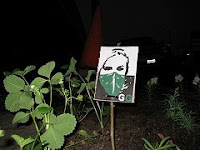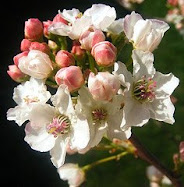 City and town environments can be harsh, monochromatic, fairly lifeless places. When I lived in the city, my favorite aspects of the surroundings, contrarily, were the parks, waterways, bordering woodlands, botanic and private gardens, the places where water flowed and plants grew. In economically depressed neighborhoods and in heavily-built municipal centers, the eyes and heart can languish for the uplifting presence of greenery, flowers, trees.
City and town environments can be harsh, monochromatic, fairly lifeless places. When I lived in the city, my favorite aspects of the surroundings, contrarily, were the parks, waterways, bordering woodlands, botanic and private gardens, the places where water flowed and plants grew. In economically depressed neighborhoods and in heavily-built municipal centers, the eyes and heart can languish for the uplifting presence of greenery, flowers, trees. For the past several years, guerrilla gardeners have embarked upon a mission to redress the paucity of plant life in urban landscapes. From New Zealand to Canada, Great Britain to South Africa, Chicago to Berlin, a loose coalition of rebel gardeners have made it their business to introduce growing, blooming specimens into city hardscapes. Sometimes it is a single rosebush at the corner of a blacktopped schoolyard, or a ladder of ivy vines against a chainlink fence, or a bed of perennials in a barren traffic island. A flow of daffodils scattered on a streetside verge. A wildflower patch sown into the neglected yard of an abandoned house. Rows of beans, squash and salad greens tucked into an empty city lot.
Richard Reynolds, an enterprising and community-spirited young English fellow, launched the present-day guerrilla gardening movement by laying claim to a lifeless, ugly traffic island in London and setting about to put it to productive, pretty use by filling it with flowers, shrubs and trees. At www.guerrillagardening.org, Mr. Reynolds lays out the premise of the movement as a “war against neglect and scarcity of public space to grow things, beautiful, tasty or both.” In photographs and words, he and the legions of guerrilla gardeners who have followed his lead document their efforts to make their locales more beautiful and useful through the reclaiming of unutilized public spaces for cultivation.
Guerrilla gardening, under various monikers, has a long and storied history. In 1649, Englishmen Gerrard Winstanley and William Everard founded the Diggers agrarian revolutionary society of unemployed laborers and peasants on the principle that common land and wasteland should be available to the poor for the raising and sharing of communal crops. Johnny Appleseed practiced a similar, if more solitary, agrarian socialism by starting orchards wherever he rambled on U.S. public land. Community gardens established in schoolyards and vacant lots, with or without official “permission,” have been a regular phenomenon in countries near and far during eras of economic hardship and food shortage. In the 1960s, the Diggers of San Francisco pursued their agenda of free food and public services, in part, by creating gardens and distributing free food in public parks. Following the horrendous tragedy of September 11, 2001, a number of New York City firehouses found themselves the recipients of volunteer garden groups who brought vitality and cheer to their doorsteps with planters, windowboxes, sidewalk flower beds.
The genius of guerrilla gardening is that anyone, child to elder, poor or rich, can practice it. It comprises an egalitarian opportunity to transform a dour, oppressive, arid spot into a place of cheer and fecundity. For little outlay beyond a bit of cogitation, physical endeavor and a few dollars, a packet of seeds can be coaxed into seedlings to be transplanted into a sidewalk or street verge. Small shrubs and seedling trees can be dug up from land that is slated for the bulldozers of approaching building development and given a new home in a traffic roundabout or other wasted city plot. Grafts and divisions of plants from one's own garden can be the basis of a new flower bed at a health clinic, jailhouse, retirement home, public housing estate.
Many city gas stations, corner shops and convenience stores have easements, foundations and sometimes even planters available and containing nothing more than dirt and weeds, when who knows? Perhaps the store owners might chip in the odd ten-spot or two to a willing worker offering to sow the brilliance and hopefulness of sedums, virburnums, cranesbill geranium, lily-of-the-valley, phlox. Sunflowers, sage and thymes, coneflowers, daisies, ivies, grapevines, honeysuckle, cottoneaster, there's a well-nigh infinite list of the perennially-flowering plants and shrubs that are tough and scrappy enough, once on their legs, to survive and flourish for years with minimal or no maintenance beyond what nature provides.
The wizardry of guerrilla gardening is that it inspires and rewards all. The gardener, and every passerby who happens upon a guerrilla garden, every community member who receives a basket of runner beans or a zuccinni, reap alike moments of grace, pleasure and bounty where previously they encountered only the empty drear. That's an insurgent warfare everyone can get behind, swapping the cruelty of swords for the goodness of ploughshares.









1 comment:
Another great idea, and blog entry! There's a traffic median near my home that will get a little guerrilla gardening as soon as the ground thaws. Thanks for the information on this underground (pun) movement.
Post a Comment